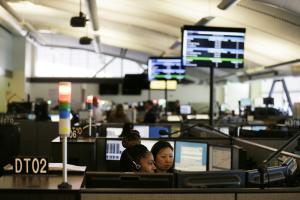 Read More
Read More
Data paves the way for alternative 911 efforts

(AP Photo/Eric Risberg)
Listen to This Article
Cities across the United States have, for years now, been testing alternative emergency response programs that help residents in need without involving armed police officers. These efforts hinge on, when appropriate, rerouting 911 calls from police to other time-sensitive care providers, such as mental-health crisis teams. The programs reflect evolving priorities around policing and public safety—and also represent opportunities to make the most of limited local budgets and police resources.
Now, the team at the Harvard Kennedy School Government Performance Lab (GPL) has released a new guide, based on three years of research in more than 30 jurisdictions, that both outlines key metrics to guide other cities’ efforts and spotlights insights into how data can help strengthen ambitious new services.
Troubleshooting outcomes as a city-wide team.
At their core, alternative emergency response programs are about successfully rerouting some distress calls to provide more specific forms of care. For instance, a city might respond to an addiction-related dispute between a mother and daughter with a social-work team that can help put the resident in need on a path toward treatment.
These programs do that by acting on key details shared with 911 operators in real time. In doing so, they can produce massive amounts of data—from the number and types of calls tackled to response times to demographic information—which can make effective management challenging.
Getting it right, according to Gabriela Solis Torres, the assistant director of GPL’s criminal justice team who leads this work, requires “not getting overwhelmed by the metrics that you have to collect and knowing which ones you should be looking at in a regular cadence.” That’s why cities are regularly convening cross-agency teams to consider key metrics—and troubleshoot outcomes together.
Take Baltimore, for example, where an alternative 911 program recently won an Innovation Award from the Maryland Association of Counties. Local leaders hold monthly meetings—a frequency suggested by GPL in their guide—that are attended by a wide range of local service providers, from police and fire officials to mental-health professionals to 911 operators. In those meetings, cities are laser-focused on data that answers a key question: When did residents slip through the cracks and get directed to the police department when they might have been better served by an alternative response? And what action items can the city take on—such as more or different training for dispatch operators—to do better next time, and send a mother worried about her daughter to the right provider? “It’s one of the most sophisticated processes I’ve seen,” says GPL project leader Aloka Narayanan.
Meetings like these are consistent with leading cities’ growing reliance on citywide data strategies to connect the dots on key priorities. But more than anything else, what stands out about this sort of approach is a new level of close cooperation, fueled by data, to create shared understanding and unlock new solutions to pressing problems.
Showcasing how new services can reduce workloads for partners.
In a best-case scenario, alternative response programs make it easier for police to focus on crime-fighting work by reducing the time they need to spend on other efforts. In Durham, N.C. the city’s alternative 911 program has managed to assemble impressive data showing just that.
The city’s dispatch system allows it to track, down to the second, how much time police spend on matters that could have been handled by alternative response teams, cross reference that number with how many calls the alternative response teams are managing, and then determine how much time these new teams are saving the police department. Between June 2022, when the city launched its alternative response team, and March of this year, that figure is an impressive 5,561 hours in saved police time. “Data points like that have been really helpful in moving forward with very broad support,” says Ryan Smith, the director of the community safety department in the city.
This sort of data is especially crucial when it comes to generating buy-in from other agencies that might be skeptical of how new efforts affect them. Or as Narayanan puts it, it allows new service providers to tell colleagues: “I am actually having a positive impact on the burden that you're facing right now.”
Planning for permanence from day one.
Another way these cities are setting their new 911 programs up for long-term success is by taking deliberate steps to keep track of demand—even if they aren’t meeting it yet.
“Even when we were only operating in a third of the city, we were able to collect data on every eligible call, regardless of when it happened, regardless of where it happened,” Durham’s Smith explains.
That allowed his team to lay out in granular detail what staff and budget they would need to move from a pilot project to a citywide service available to every resident. Their hard work paid off: The team was granted that funding and is now hoping to move from a service with limited hours to one that’s available around the clock. Durham’s success is making waves across the state, too, with Raleigh and Asheville looking to replicate its holistic alternative 911 approach.
Smith, who once led his city’s Bloomberg Philanthropies-funded innovation team (or i-team), says this simple framework—data making the case for scale—can be applied to any new local-government undertaking. It just requires some foresight.
“You ought to be really thoughtful about the data that you want to be collecting from day one,” he says.

